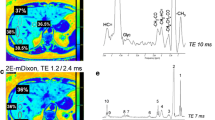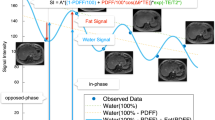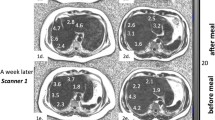Abstract
A recently published Dixon-based MRI method for quantifying liver fat content using dual-echo breath-hold gradient echo imaging was validated by phantom experiments and compared with results of biopsy in two patients (Radiology 2005;237:1048-1055). We applied this method in ten healthy volunteers and compared the outcomes with the results of MR spectroscopy (MRS), the gold standard in quantifying liver fat content. Novel was the use of spectroscopic imaging yielding the variations in fat content across the liver rather than a single value obtained by single voxel MRS. Compared with the results of MRS, liver fat content according to MRI was too high in nine subjects (range 3.3–10.7% vs. 0.9–7.7%) and correct in one (21.1 vs. 21.3%). Furthermore, in one of the ten subjects the MRI fat content according to the Dixon-based MRI method was incorrect due to a (100-x) versus x percent lipid content mix-up. The second problem was fixed by a minor adjustment of the MRI algorithm. Despite systematic overestimation of liver fat contents by MRI, Spearman’s correlation between the adjusted MRI liver fat contents with MRS was high (r = 0.927, P < 0.001). Even after correction of the algorithm, the problem remaining with the Dixon-based MRI method for the assessment of liver fat content,is that, at the lower end range, liver fat content is systematically overestimated by 4%.




Similar content being viewed by others
References
Adams LA, Sanderson S, Lindor KD, Angulo P (2005) The histological course of nonalcoholic fatty liver disease: a longitudinal study of 103 patients with sequential liver biopsies. J Hepatol 42:132–138
Dam-Larsen S, Franzmann MB, Christoffersen P, Larsen K, Becker U, Bendtsen F (2005) Histological characteristics and prognosis in patients with fatty liver. Scand J Gastroenterol 40:460–467
Volzke H, Robinson DM, Kleine V, Deutscher R, Hoffmann W, Ludemann J, Schminke U, Kessler C, John U (2005) Hepatic steatosis is associated with an increased risk of carotid atherosclerosis. World J Gastroenterol 11:1848–1853
Browning JD, Szczepaniak LS, Dobbins R, Nuremberg P, Horton JD, Cohen JC, Grundy SM, Hobbs HH (2004) Prevalence of hepatic steatosis in an urban population in the United States: impact of ethnicity. Hepatology 40:1387–1395
Szczepaniak LS, Nurenberg P, Leonard D, Browning JD, Reingold JS, Grundy S, Hobbs HH, Dobbins RL (2005) Magnetic resonance spectroscopy to measure hepatic triglyceride content: prevalence of hepatic steatosis in the general population. Am J Physiol Endocrin Metab 288:E462–E468
Targher G, Bertolini L, Padovani R, Zenari L, Zoppini G, Falezza G (2004) Relation of nonalcoholic hepatic steatosis to early carotid atherosclerosis in healthy men: role of visceral fat accumulation. Diabetes Care 27:2498–2500
Kim SH, Lee JM, Han JK, Lee JY, Lee KH, Han CJ, Jo JY, Yi NJ, Suh KS, Shin KS, Jo SY, Choi BI (2006) Hepatic macrosteatosis: predicting appropriateness of liver donation by using MR imaging - correlation with histopathologic findings. Radiology 240:117–129
Hussain HK, Chenevert TL, Londy FJ, Gulani V, Swanson SD, McKenna BJ, Appelman HD, Adusumilli S, Greenson JK, Conjeevaram HS (2005) Hepatic fat fraction: MR imaging for quantitative measurement and display-early experience. Radiology 237:1048–1055
Kawamitsu H, Kaji H, Ohara T, Sugimura K (2003) Feasibility of quantitative intrahepatic lipid imaging applied to the magnetic resonance dual gradient echo sequence. Magn Reson Med Sci 2:47–50
Machann J, Thamer C, Schnoedt B, Stefan N, Haring HU, Claussen CD, Fritsche A, Schick F (2006) Hepatic lipid accumulation in healthy subjects: a comparative study using spectral fat-selective MRI and volume-localized 1H-MR spectroscopy. Magn Reson Med 55:913–917
Valls C, Iannacconne R, Alba E, Murakami T, Hori M, Passariello R, Vilgrain V (2006) Fat in the liver: diagnosis and characterization. Eur Radiol 16:2292–2308
Thomsen C, Becker U, Winkler K (1994) Quantification of liver fat using magnetic resonance spectroscopy. Magn Reson Imaging 12:487–495
Sijens PE, Smit GP, Borgdorff MAJ, Kappert P, Oudkerk M (2006) Multiple voxel 1H MR spectroscopy of phosphorylase-b kinase deficient patients (GSD IXa) showing an accumulation of fat in the liver that resolves with aging. J Hepatol 45:851–855
Sijens PE, van den Bent MJ, Nowak PJCM, van Dijk P, Oudkerk M (1997) 1H Chemical shift imaging reveals loss of brain tumor choline signal after administration of Gdcontrast agent. Magn Reson Med 37:222–225
Longo R, Ricci C, Masutti F, Vidimari R, Crocé LS, Bercich L, Tiribelli C, Dalla Palma L (1993) Fatty infiltration of the liver. Quantification by 1H localized magnetic resonance spectroscopy and comparison with computed tomography. Invest Radiol 4:297–302
Tiikkainen M, Bergholm R, Vehkavaara S, Rissanen A, Häkkinen A-M, Tamminen M, Teramo K, Yki-Järvinen H (2003) Effects of identical weight loss on body composition and features of insulin resistance in obese women with high and low liver fat content. Diabetes 52:701–707
Adiels M, Taskinen M-R, Packard C, Caslake MJ, Soro-Paavonen A, Westerbacka J, Yehkavaara S, Häkkinen A, Olofsson S-O, Yki-Järvinen H, Borén J (2006) Overproduction of large VLDL particles is driven by increased liver fat content in man. Diabetologia 49:755–765
Biglands JD, Wilson D, Ward J, Treanor D, Gurthry A, Nijhawan A, Smith J, Wyatt J, Robinson P (2007) Comparison of MRI and histopathalogic methods of quantifying hepatic fat fraction. In: Proc Intl Soc Magn Reson Med, May 19–25, 2007, Berlin, p 2703
Cotler SJ, Guzman G, Layden-Almer J, Mazzone T, Layden TJ, Zhou XJ (2007) Measurement of liver fat content using selective saturation at 3.0 T. J Magn Reson Imaging 25:743–748
Acknowledgement
The authors thank P. Kappert, J.H. Potze, and I. Willebordse for scanning the volunteers.
Author information
Authors and Affiliations
Corresponding author
Rights and permissions
About this article
Cite this article
Irwan, R., Edens, M.A. & Sijens, P.E. Assessment of the variations in fat content in normal liver using a fast MR imaging method in comparison with results obtained by spectroscopic imaging. Eur Radiol 18, 806–813 (2008). https://doi.org/10.1007/s00330-007-0801-0
Received:
Revised:
Accepted:
Published:
Issue Date:
DOI: https://doi.org/10.1007/s00330-007-0801-0




